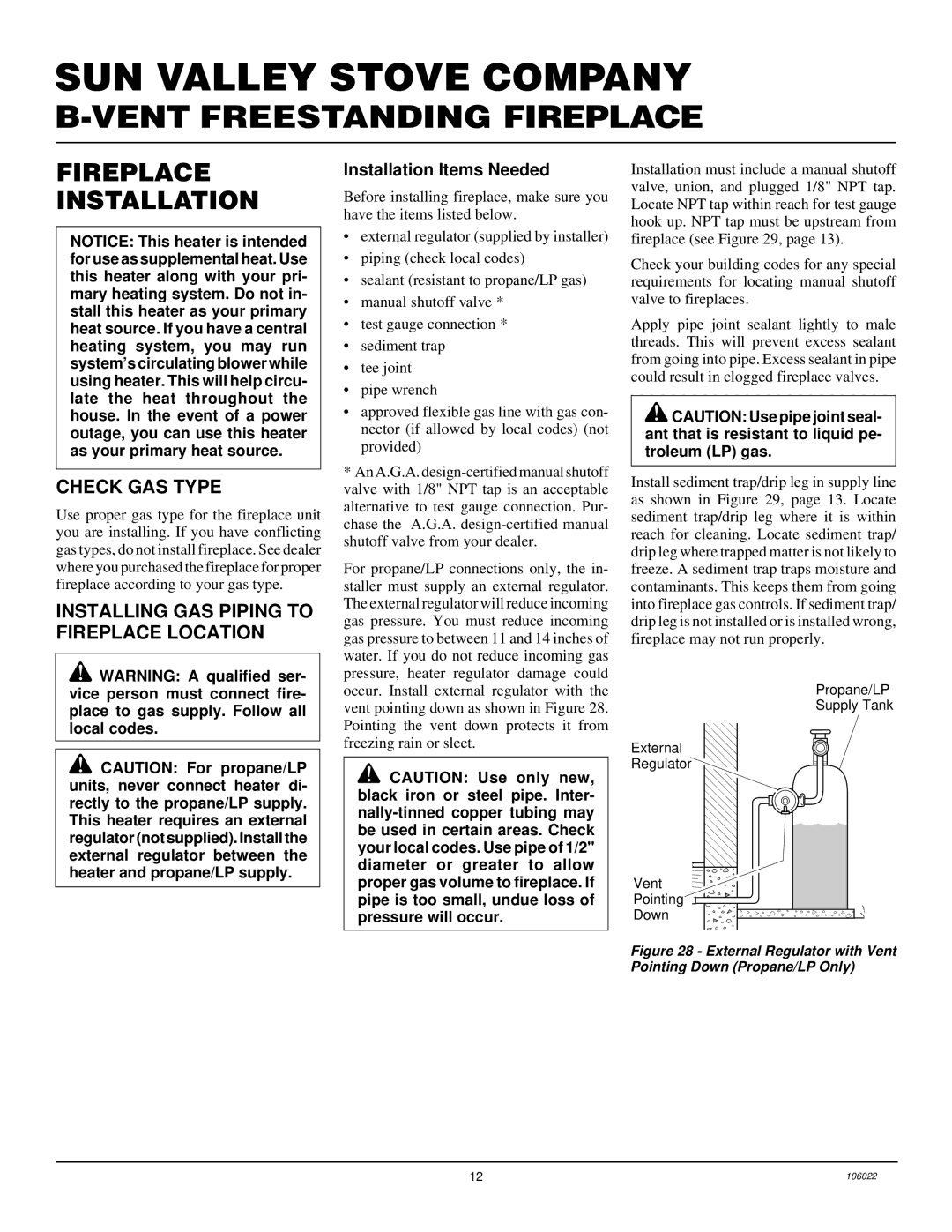
SUN VALLEY STOVE COMPANY
B-VENT FREESTANDING FIREPLACE
FIREPLACE INSTALLATION
NOTICE: This heater is intended for use as supplemental heat. Use this heater along with your pri- mary heating system. Do not in- stall this heater as your primary heat source. If you have a central heating system, you may run system’s circulating blower while using heater. This will help circu- late the heat throughout the house. In the event of a power outage, you can use this heater as your primary heat source.
CHECK GAS TYPE
Use proper gas type for the fireplace unit you are installing. If you have conflicting gas types, do not install fireplace. See dealer where you purchased the fireplace for proper fireplace according to your gas type.
INSTALLING GAS PIPING TO FIREPLACE LOCATION
![]() WARNING: A qualified ser- vice person must connect fire- place to gas supply. Follow all local codes.
WARNING: A qualified ser- vice person must connect fire- place to gas supply. Follow all local codes.
![]() CAUTION: For propane/LP units, never connect heater di- rectly to the propane/LP supply. This heater requires an external regulator (not supplied). Install the external regulator between the heater and propane/LP supply.
CAUTION: For propane/LP units, never connect heater di- rectly to the propane/LP supply. This heater requires an external regulator (not supplied). Install the external regulator between the heater and propane/LP supply.
Installation Items Needed
Before installing fireplace, make sure you have the items listed below.
•external regulator (supplied by installer)
•piping (check local codes)
•sealant (resistant to propane/LP gas)
•manual shutoff valve *
•test gauge connection *
•sediment trap
•tee joint
•pipe wrench
•approved flexible gas line with gas con- nector (if allowed by local codes) (not provided)
*An A.G.A.
For propane/LP connections only, the in- staller must supply an external regulator. The external regulator will reduce incoming gas pressure. You must reduce incoming gas pressure to between 11 and 14 inches of water. If you do not reduce incoming gas pressure, heater regulator damage could occur. Install external regulator with the vent pointing down as shown in Figure 28. Pointing the vent down protects it from freezing rain or sleet.
![]() CAUTION: Use only new, black iron or steel pipe. Inter-
CAUTION: Use only new, black iron or steel pipe. Inter-
Installation must include a manual shutoff valve, union, and plugged 1/8" NPT tap. Locate NPT tap within reach for test gauge hook up. NPT tap must be upstream from fireplace (see Figure 29, page 13).
Check your building codes for any special requirements for locating manual shutoff valve to fireplaces.
Apply pipe joint sealant lightly to male threads. This will prevent excess sealant from going into pipe. Excess sealant in pipe could result in clogged fireplace valves.
![]() CAUTION: Use pipe joint seal- ant that is resistant to liquid pe- troleum (LP) gas.
CAUTION: Use pipe joint seal- ant that is resistant to liquid pe- troleum (LP) gas.
Install sediment trap/drip leg in supply line as shown in Figure 29, page 13. Locate sediment trap/drip leg where it is within reach for cleaning. Locate sediment trap/ drip leg where trapped matter is not likely to freeze. A sediment trap traps moisture and contaminants. This keeps them from going into fireplace gas controls. If sediment trap/ drip leg is not installed or is installed wrong, fireplace may not run properly.
Propane/LP
Supply Tank
External
Regulator
Vent
Pointing
Down
Figure 28 - External Regulator with Vent Pointing Down (Propane/LP Only)
12 | 106022 |
